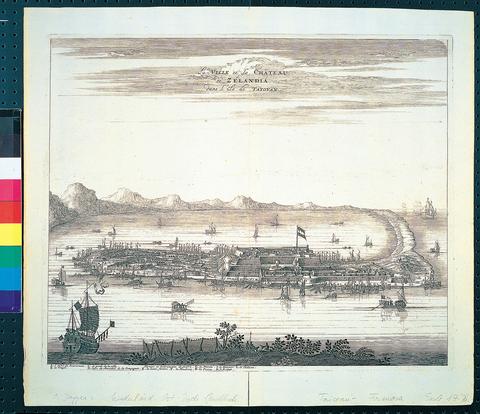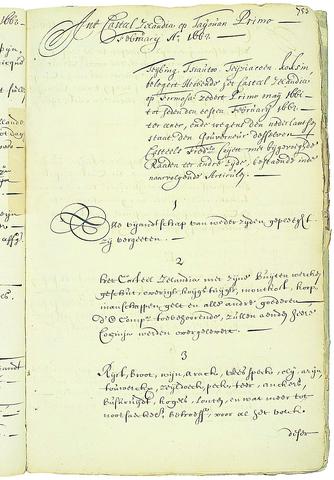In 1603, Dutch ships ventured into the waters of the South China Sea searching for a base from which to open trade with China. They bore the commission and the guns of the then one-year-old Verenigde Oost-Indische Compagnie (VOC), or the Dutch East India Company, which was working out of a new base in Batavia (now Jakarta), through which it would funnel nearly all Asian trade for the next 200 years.
But access to the riches of East Asia wasn't easy. After Ming dynasty forces kicked the Dutch out of what is now Penghu for the second time in 1624, the European traders were allowed to take possession of a larger island beyond the Penghu archipelago to the west. They settled near present day Tainan on a sandbar islet that they inferred from local speech was called "Tayouan" or "Taywan." The name was eventually used to identify the entire island, but did it also produce an identity?

A case for this historical origin of Taiwan -- and by this I don't just mean an Aboriginal word for some sandbar, but instead the international perception of Taiwan as a place distinct from China -- is advocated in The Birth of Taiwan: Formosa in the Seventeenth Century (

Two years in the planning, the exhibition focuses on the Taiwan of the Dutch colonial era (1624-1662), taking full advantage of the VOC's rich legacy of historical records, maps, trade wares and other sundry artifacts. Its contents include more than 270 pieces from more than 35 museums in Taiwan and Europe. Several are rare and fascinating finds, like a handwritten dictionary that translates Aboriginal names from Sinkanese, a Dutch romanization of an Aboriginal language, into Chinese characters.
The lexicon is just one of many details of a show that offers the most complete and interesting picture of Dutch-occupied Taiwan ever exhibited locally, or for that matter, probably anywhere in the world.
At the time of the Dutch arrival in 1624, little was known about Taiwan. China's court records produced conflicting accounts, and the Portuguese, who never really spent much time in Taiwan even though they christened the "Ihla Formosa" after spying it from a ship three-quarters of a century earlier, depicted it on their maps as a string of three separate islands. Taiwan was not mapped as a single body by Europeans until the first Dutch governor of Taiwan, a man named Snock, in 1625 sent the cartographer Nordeloos to circumnavigate his new territory and map the coastline.
But maps are only one topic explored. Another major element is the introduction of Dutch trade and technology and the transformations that ensued. Under the guidance of a group known as the Seventeen Gentlemen, the VOC's directors in Amsterdam, Taiwan became a Dutch transit hub with major links to both China and Japan. It moved Chinese silks and porcelain, Indonesian pepper and Japanese silver. Taiwan's sugarcane, silk, and skins of the abundant Formosan deer, whose hides were used by the Japanese in the manufacture of samurai armor.
Dutch journals and engravings show an ethnographic interest in the native Formosans, the Aborigines of the Pingpu (平埔) tribe. There were few Chinese settlers in the Taiwan of the 1620s, though by the time the Dutch left that had changed. In a push for development, the new colonists introduced European-style agriculture and imported water buffaloes and plows from China. Han Chinese colonists followed. There were an estimated 40,000 of them by 1662, the year the Dutch were expelled at the hands of Koxinga (鄭成功).
Koxinga was a pirate warlord who rebelled against the encroaching Manchus, maintaining loyalty to the Ming even after the 1644 suicide of its last emperor, Chung Chen (崇禎). In the years that followed he continued to foment resistance in southern China, but a 1659 defeat forced his 1661 retreat to Taiwan. He landed with an army of 25,000 and immediately contested the Dutch, laying siege to the Dutch fort of Zeelandia at Tainan. The Dutch held out for nine months at the cost of 1,600 lives before signing a treaty that allowed them to leave peaceably with the majority of their possessions.
The treaty, an impressive tome of compiled Dutch records from much of the occupation, is on display, as are the 18 terms of surrender proposed by Governor Frederick Coyett and the 16 eventually accepted by Koxinga. The first of them states that both parties shall renounce hostilities and forget all previous conflicts. Predictably, this never happened. A year later, the Dutch returned with 16 men-of-war in an attack that was repelled, and as recently as the fall of 2001, Taiwanese baseball fans were still waving placards bearing Koxinga's likeness while Taiwan and the Netherlands squared off in the 2001 Baseball World Cup.
Unfortunately the exhibition basically ends with the Coyett's 1662 surrender. There is little mention of the Spanish presence in northern Taiwan at Tamsui from 1624-1642 or the Kingdom of Taiwan, which existed under Koxinga's heirs from 1662-1683, ending with the conquest of Taiwan by the Qing. The absences can be accounted for by scarcity of records from those segments of history, especially in comparison to the abundance of VOC records now scattered throughout the world's museums. Also, as the show makes a case for the birth of Taiwan that was separate from China, it would probably not want to finish off with the actual conclusion of the 17th century, a Taiwan under Chinese rule.
The Birth of Taiwan: Formosa in the Seventeenth Century is on display through April 30 at the National Palace Museum (

On April 26, The Lancet published a letter from two doctors at Taichung-based China Medical University Hospital (CMUH) warning that “Taiwan’s Health Care System is on the Brink of Collapse.” The authors said that “Years of policy inaction and mismanagement of resources have led to the National Health Insurance system operating under unsustainable conditions.” The pushback was immediate. Errors in the paper were quickly identified and publicized, to discredit the authors (the hospital apologized). CNA reported that CMUH said the letter described Taiwan in 2021 as having 62 nurses per 10,000 people, when the correct number was 78 nurses per 10,000

As we live longer, our risk of cognitive impairment is increasing. How can we delay the onset of symptoms? Do we have to give up every indulgence or can small changes make a difference? We asked neurologists for tips on how to keep our brains healthy for life. TAKE CARE OF YOUR HEALTH “All of the sensible things that apply to bodily health apply to brain health,” says Suzanne O’Sullivan, a consultant in neurology at the National Hospital for Neurology and Neurosurgery in London, and the author of The Age of Diagnosis. “When you’re 20, you can get away with absolute

When the South Vietnamese capital of Saigon fell to the North Vietnamese forces 50 years ago this week, it prompted a mass exodus of some 2 million people — hundreds of thousands fleeing perilously on small boats across open water to escape the communist regime. Many ultimately settled in Southern California’s Orange County in an area now known as “Little Saigon,” not far from Marine Corps Base Camp Pendleton, where the first refugees were airlifted upon reaching the US. The diaspora now also has significant populations in Virginia, Texas and Washington state, as well as in countries including France and Australia.

May 5 to May 11 What started out as friction between Taiwanese students at Taichung First High School and a Japanese head cook escalated dramatically over the first two weeks of May 1927. It began on April 30 when the cook’s wife knew that lotus starch used in that night’s dinner had rat feces in it, but failed to inform staff until the meal was already prepared. The students believed that her silence was intentional, and filed a complaint. The school’s Japanese administrators sided with the cook’s family, dismissing the students as troublemakers and clamping down on their freedoms — with